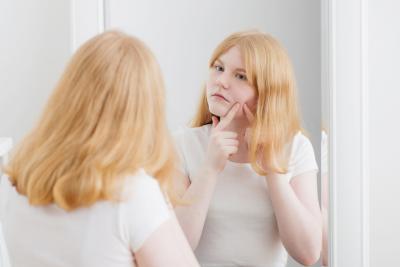Guide to Acne Development and Treatment Using Over-the-Counter Products
WHO gets acne:
- Up to 90% of adolescents develop acne
- Acne usually starts around ages 7-12 years old and resolves by 30 years old
- Typically the most severe acne for boys is during adolescence, but for girls may be later
- There is a big range in acne severity, from very mild to very severe

HOW acne happens:
- Acne is a problem of the skin cells, nearby sebaceous glands (that make the body’s natural body oils aka sebum), and C. acnes bacteria (found on the surface of all skin)
- When skin cells do not shed properly and there is increased production of sebum, black heads (open comedones) and white heads (closed comedones) develop from the accumulation of the skin cells’ keratin and the sebum
- C. acnes feasts on the trapped sebum. The body’s immune system reacts by sending out white blood cells to attack this hungry bacteria
- The white blood cells form pus, which leads to the development of pustules surrounded by redness/inflammation
WHY teens get acne:
- Teens have increased levels of the hormones called androgens and testosterone
- These hormones stimulate the sebaceous glands to produce more sebum/oil, which is more food for the C. acnes bacteria
Left: Non-inflammatory acne with closed comedones (“white heads”) and open comedones (“black heads”)
Right: Inflammatory acne with pustules and surrounding inflammation
What everybody should do to keep their skin healthy:
- Wash your face twice a day with a gentle cleanser (Cetaphil, CeraVe, Neutrogena, etc.)- do not scrub the skin aggressively
- Keep skin moisturized by applying an oil-free moisturizer after washing your face
- Wear broad-spectrum sunscreen- some moisturizers even contain SPF
- Choose make-up that is “non-comedogenic,” or avoid wearing make-up completely
Topical retinoids:
- Work by reducing inflammation and breaking down white heads and back heads
- Adapalene 0.1% (Differin®) is the only retinoid available without a prescription
- Use these products for non-inflammatory and inflammatory acne
- How to use: Apply a thin layer of adapalene after washing your face at night
- Warning: can increase the risk of sunburn, so it’s best to use this product at night
Benzoyl peroxide:
- Works by killing the acne causing bacteria (C. acnes)
- Available in many strengths (2.5%-10%)- start with 2.5% and increase as needed
- Add this product to your skin care regimen if you have inflammatory acne
- How to use: Apply a thin layer of benzoyl peroxide after washing face in the morning and/or at night. You can apply this simultaneously with adapalene.
- Warning: can bleach clothes and pillow cases, so may want to apply carefully in the morning or use white pillow cases
- Available in the form of lotions and creams (best for dryer skin) as well as gels (best for oily skin)
Helpful tips for using adapalene and benzoyl peroxide:
- Use a thin layer of the product- a pea-sized amount should cover the entire face
- Don't just apply the product to the pimples, apply it to the entire face
- Skin irritation, dryness, and flaking are common with use of these products. If this occurs, use the product every 2-3 days instead of daily.
- Salicylic acid products can be added to improve your skin care regimen, or substituted for adapelene if too much dryness is occuring.
- If you have acne on your body, try benzoyl peroxide washes to cover large areas of skin.
- Patience is important- usually improvement can be noticed after 2 weeks of treatment, but maximum effects aren’t apparent until after 2 months
- Try not to pick at your acne, this can lead to more inflammation and scar formation.
When to discuss acne with your pediatrician:
- If your acne is severe or not significantly better with over-the-counter treatments
- If there is scarring or cyst formation from your acne
- If there is a lot of acne on your body, not just your face
- For females, if your acne is much worse around the time of your periods
- Anytime you have additional questions or concerns
More information about acne for teens and parents can be found at healthychildren.org.
